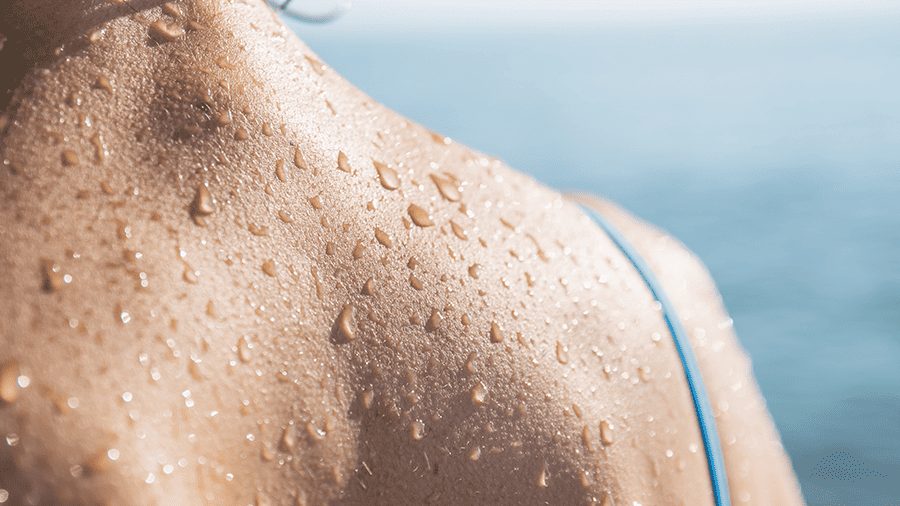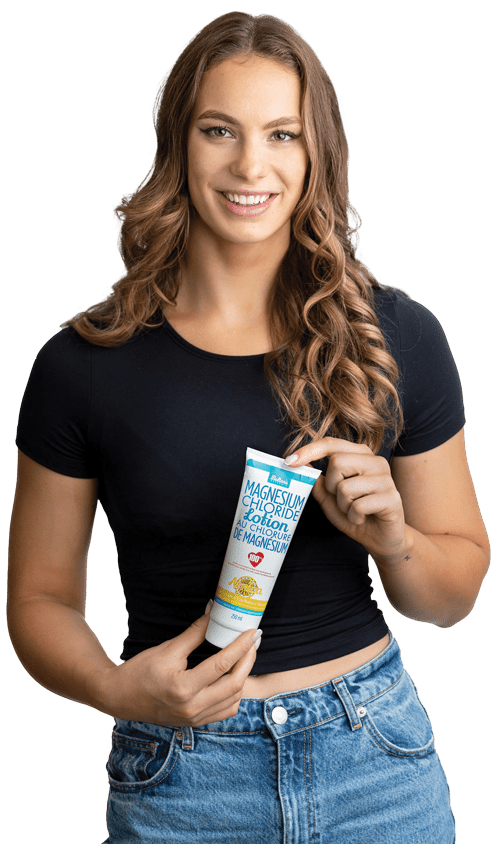Magnesium Absorption Through The Skin
In previous posts, I’ve talked about high magnesium needs and what to do if you fall into that category, whether because of your size, health or lifestyle factors. I briefly introduced the benefits of using topical, or ‘transdermal’ magnesium to boost your intake. Now, if you’re just starting out with topical magnesium, you may be wondering how to use it. There are three different products in our topical line, and each is slightly different. Let’s start with the easiest. Magnesium Chloride Spray Natural Calm Canada’s crystal clear, odour free Magnesium Chloride Liquid is a brine from distilled concentrated sea water that feels like an oil. Our Magnesium Spray is a diluted version of the full-strength product (see below), and it comes in a convenient spray bottle for instant application. If you’re looking for a product that can be applied directly to the skin, the spray is a great option. How much should you use? In 10 sprays, or 1 ml, there are 60 mg of elemental magnesium and 90 trace minerals. To give you an idea of how you might distribute this across the body, here’s a quick guide: 1 spray each top of foot = 21 spray each bottom of foot = 21 spray each front of calf = 21 spray each back of calf = 21 spray each front of thigh = 21 spray each back of thigh = 21 spray each glute = 21 spray each hip = 21 spray lower back = 11 spray midback = 11 spray each side of upper back = 21 spray each shoulder = 21 spray back of neck = 11 spray each bicep area = 21 spray each forearm = 21 spray upper face/forehead (covering eyes) = 11 spray lower face (covering eyes) = 11 spray each side of upper chest = 21 spray abdominal area = 1 If you follow this guide, you’ll apply 32 sprays to your entire body, and over 180 mg of highly-absorbable magnesium chloride. Allow the Mag Spray to air dry before putting on clothing. It isn’t necessary to rinse, but if you wish to do so, wait 20-30 minutes after application, to allow the product to really soak in. Use daily! Magnesium Chloride Gel Magnesium Chloride Gel is topical magnesium designed for massage. Like the spray, Magnesium Chloride Gel can be applied directly to the skin, without sensitivity for most users. Magnesium Chloride Gel contains the same magnesium chloride as the spray, but combined with a ‘carrying agent’ called Amigel. As you can imagine, the carrying agent holds the liquid magnesium in more viscous form. Instead of forming a thin layer on the skin, like the spray, the gel holds the magnesium in a thicker layer on the skin, while the body absorbs the mineral. People love Magnesium Chloride Gel for relief from tense muscles, aches, pains and other symptoms of magnesium deficiency. How much should you use? In each ml of gel, there are 60 mg of elemental magnesium and 90 trace minerals. So, if you were to measure out 1 tsp (5 ml), you could expect to apply 300 mg of magnesium to your skin. That’s concentrated! Magnesium Chloride Liquid Magnesium Chloride Liquid is a more concentrated version of our spray product. It’s twice as strong as the spray, and has a cap instead of a spray top. Unless you’re a seasoned user, try diluting the product at home before use. Mix the Magnesium Chloride Liquid with pure water and rub into the skin, or add it to your own spray bottle and apply as above. You can also add full-strength Magnesium Chloride Liquid to a bath, or a foot soak. For application to the face, try using a cotton pad and wiping the Magnesium Chloride Liquid over the skin. It’s a great toner, helps with dry, rough skin and is purported to activate anti-aging DHA. Seasoned users can try pouring a small amount of Magnesium Chloride Liquid into their cupped palm, and applying directly to a larger surface area, like the torso. Allow the Magnesium Chloride Liquid to air dry before putting on clothing. It isn’t necessary to rinse, but if you wish to do so, wait 20-30 minutes after application, to allow the product to really soak in. How much should you use? There are 120 mg of elemental magnesium and 90 trace minerals in 1 ml of the full-strength Magnesium Chloride Liquid (that’s 2x the magnesium of the spray). Try adding 5 ml (1 tsp) to a bath Use daily! Pro-tip: Make a Compress! Above we’ve described the basic application for these products – simple, convenient ways to use topical magnesium. But if you have a particularly painful or tense area of the body, you may want to try a hot compress. Works like a charm! Let us know if you have any questions or comments on using our magnesium chloride products.
Topical Magnesium Absorption

Transdermal Magnesium and Evidence to Support Its Efficacy White Paper by Alison Smith Ph.D. Magnesium is required in over 300 physiological processes in the body and is essential to human health1. Surprisingly, 43% of Canadians and 68% of Americans are not consuming even the minimum daily requirement of magnesium2,3; therefore, supplementation is necessary4,5. There is a breadth of scientific evidence that oral magnesium supplements, containing organic magnesium salts, readily absorb through the intestinal mucosa to become bioavailable in the bloodstream6-10. Oral magnesium supplements, however, are not the only commercially available form of magnesium on the market––transdermal or topical preparations of magnesium are also accessible; although, are they just as effective as oral magnesium supplements in terms of absorbability and bioavailability? Can one simply apply a topical magnesium cream, gel, ointment, or spray, or bathe in water containing magnesium salts and expect to absorb the magnesium through the skin to increase bioavailability within the blood? Göber et al. 11 asserts that transdermal magnesium absorption is a myth. Here we’ll discuss whether this assertion is supported or refuted in the scientific literature. Skin Structure and Permeability The skin is the largest organ of the body12 and functions to provide a robust barrier between the internal body and external environment. Designed primarily to keep harmful substances out and internal structures and moisture within13, the skin is composed of three layers: stratum corneum, epidermis, and dermis12. The strength and seemingly impenetrable nature of the skin is due in part to the stratum corneum––the outer layer of the skin that shields the epidermis14. The stratum corneum is made up of tough keritanized epithelial cells surrounded by layers of lipids (fats). The layers of lipids prevent moisture loss from within the body and block entry of most substances applied to the skin, topically. It is continually renewed and regenerated as the outermost stratum corneum cells slough off from the surface of the skin. Interspersed throughout the stratum corneum are pores (sweat glands) and hair follicles that form passageways that lead directly to the deeper layers of the skin and systemic circulation13. The outstanding questions are whether magnesium can penetrate the stratum corneum or can magnesium enter the bloodstream via the pores or hair follicles. The proceeding sections of this white paper will present all evidence pertaining to transdermal magnesium absorption in hopes of answering these two questions. Scientific Evidence of Transdermal Magnesium Absorption Magnesium is a metallic ion, and there is evidence that metallic ions can penetrate the stratum corneum of the skin15. There are very few studies that have measured blood serum, urine, or intracellular concentration of magnesium following transdermal magnesium application; however, here is a synopsis of the current scientific findings: Transdermal Magnesium in the Treatment of Health Conditions While little quantitative data is currently available to confirm magnesium absorption transdermally, topical magnesium preparations are frequently used by the medical community to successfully treat various medical conditions. Most readers will be aware that transdermal administration of medications is common in the treatment of local skin related conditions and more systemic issues. Applying a medication directly to the skin avoids the breakdown of the medication in the gastrointestinal tract or filtering by the liver––two processes that affect oral medication administration13. Transdermal Magnesium for Ileostomy Complications An ileostomy is a surgical procedure whereby a portion of the ileum (small intestine) is rerouted to an external opening (stoma) on the side of the abdomen and connected to an external bag to allow feces to leave the body. This type of procedure is necessary for those who must have their colon removed for medical reasons20. A high output ileostomy is a common complication of this procedure, which results in a rapid and high yield elimination of waste from the body in 51% of patients, resulting in dehydration, undernutrition, and magnesium deficiency (hypomagnesemia) 20. To treat the magnesium deficiency, ileostomy patients receive intravenous (IV) magnesium infusions rather than oral magnesium supplements since intestinal absorption is compromised. In a study of 6 ileostomy patients, Al Bakir et al. 21 investigated the efficacy of transdermal magnesium to treat ileostomy patients with hypomagnesemia. Results indicated that 50% of patients who received 150 mg of transdermal elemental magnesium per day for 6 weeks increased their serum and urine concentration of magnesium, and one patient was able to cancel their scheduled magnesium IV infusion. Also, 83% of patients reported an improvement or complete resolution of muscle cramping by week two of the study. This pilot study, unfortunately, only included 6 subjects, but it does provide preliminary evidence that transdermal magnesium in an oil-based vehicle can potentially increase the bioavailability of magnesium in ileostomy patients. Topical Magnesium and Psoriatic Arthritis Psoriatic arthritis (PsA) is a chronic inflammatory disease, linked to genetic and environmental influences, which affect the skin and joints. PsA is associated with psoriasis and can cause red, swollen, and scaly skin lesions; nail deformity; swollen, red, and painful fingers; and, inflamed, painful tendon attachments to bone. It is often treated with pharmaceutical interventions22. There is one study by Elkayam et al. 23 that measured the effectiveness of soaking in the Dead Sea on PsA signs and symptoms. (The predominate mineral in the Dead Sea according to Proksch24 is magnesium.) The study divided 42 PsA patients into two groups: both groups soaked in the Dead Sea every day for 4 weeks, while Group 1 received an addition topical application of Dead Sea mud and sulphur baths. Following the 4-week intervention, patients reported a decrease in psoriasis area, severity index (PASI) score, morning stiffness, distance from finger to floor when bending forward, and self-assessment of disease severity. There was also an increase in the Schober test (lumbar spine range of motion) and right and left hand grip. This study did not assess pre and post serum or urinary magnesium levels; therefore, it is difficult to make any conclusions on the effectiveness of magnesium salt exposure from the Dead Sea to increase the bioavailability of magnesium in PsA patients. Transdermal Magnesium and Psoriasis Psoriasis is an autoimmune condition that is characterized by red, scaly skin with raised plaques. Under normal conditions, the outer stratum corneum sloughs off dead skin cells from the
Ultimate Guide to Topical Magnesium Chloride
We get a lot of questions about our topical magnesium chloride products. That’s why we’ve written this Ultimate Guide. Beginning with the ‘what’ and ‘why’, we move on to the ‘how’, ‘how much’, ‘how effective’ and ‘how safe’ questions people frequently ask. What is magnesium chloride? Magnesium chloride is what’s called a ‘magnesium salt’. It’s a compound of the mineral, magnesium, and the essential electrolyte, chloride. Magnesium is used in hundreds of processes across the body. It’s essential for chemical reactions, the production and transport of energy, synthesis of protein, transmission of nerve signals, muscle function, healthy DNA, and more.1 Chloride is found in all body fluids, and it is responsible for maintaining pH balance, transmitting nerve impulses and regulating fluid into and out of cells. You may have also heard of magnesium chloride hexahydrate (MCH) lately, and wondered whether it’s the same compound. MCH is chemically produced in a lab, in contrast to the magnesium chloride we use, which is harvested directly from seawater. Hexaydrate means “without water” and when MCH transdermal brands make magnesium spray, cream or “oil”, they rehydrate these lab-produced magnesium flakes. What difference does it make? MCH only includes magnesium chloride without the 90+ naturally-occurring trace minerals found in magnesium chloride from seawater. There’s reason to believe that these trace minerals in seawater are also beneficial to our health. What do we mean by topical magnesium? Magnesium chloride, sometimes referred to as “magnesium oil”, is known as a topical magnesium. In other words, magnesium chloride can be absorbed through the skin. Today, we’re more aware than ever that the substances we apply to the skin are absorbed into the bloodstream. That’s why some medications are delivered through a skin patch, and it’s also why we need to be careful about what products we apply to our face and body. But we can also use natural topical products therapeutically. People have been using minerals like magnesium topically for thousands of years. Ancient Romans and their predecessors may not have known that minerals could explain their healing baths, but they knew that long soaks in certain waters were beneficial to health. Is magnesium chloride a natural product? How is it made? Magnesium chloride liquid is a natural product, extracted from brine or seawater. Ours comes from salt evaporation ponds along the coast of southern California. The Dead Sea in the Jordan valley is another well-known source. The ocean water captured in the ponds is allowed to sit for several months until it becomes a concentrated form of magnesium chloride. Ours also contains 80 to 90 other trace minerals, naturally occurring in ocean water. Liquid magnesium chloride can be added to other solutions, like the massage gel we use in our Magnesium Chloride Gel or Balm. Magnesium chloride can be mixed with oils (as it is in the balm), but it’s a common misconception that magnesium chloride is an oil. This type of magnesium is popularly known as “magnesium oil” because of the viscous, slippery texture. Magnesium chloride is also available in ‘flakes’, a solid, crystallized format used for baths, like Epsom salts. The flakes are prepared by heating the magnesium chloride liquid until the water is completely evaporated. In the process, the chemical structure of the product changes and it becomes a less concentrated form of magnesium chloride. Who needs magnesium? We all need magnesium every day. And most of us aren’t getting enough through diet. Magnesium can help with nerves, muscles, heart, hormones, bones, teeth, and more. It provides relief from stress, improves sleep, reduces pain and has innumerable benefits. That’s because magnesium is an essential mineral for health. Athletes and anyone with chronic body pain, or Restless Leg Syndrome tend to love topical magnesium. If you have cramps (PMS-related or otherwise), you’ll appreciate the muscle-relaxing effects. We’re often asked if our magnesium products are safe during pregnancy. Unless you have a serious health condition, you can feel confident taking magnesium at a normal dose. Magnesium is great for pregnancy-related cramping and to keep blood pressure low, essential for a healthy, full-term delivery. Topical magnesium is suitable for almost anyone. To learn more about the safety and benefits of supplemental magnesium, read Dr. Carolyn Dean’s book, The Magnesium Miracle. Why choose topical magnesium? Many people think of topical magnesium as a treatment for sore muscles. It is that, and much more. You can expect all of the renowned benefits of magnesium from topicals: better sleep, relief from stress, pain, tension, plus the long-term protective effects for heart-health and more. Here’s why you might want to add magnesium chloride to your regime:


